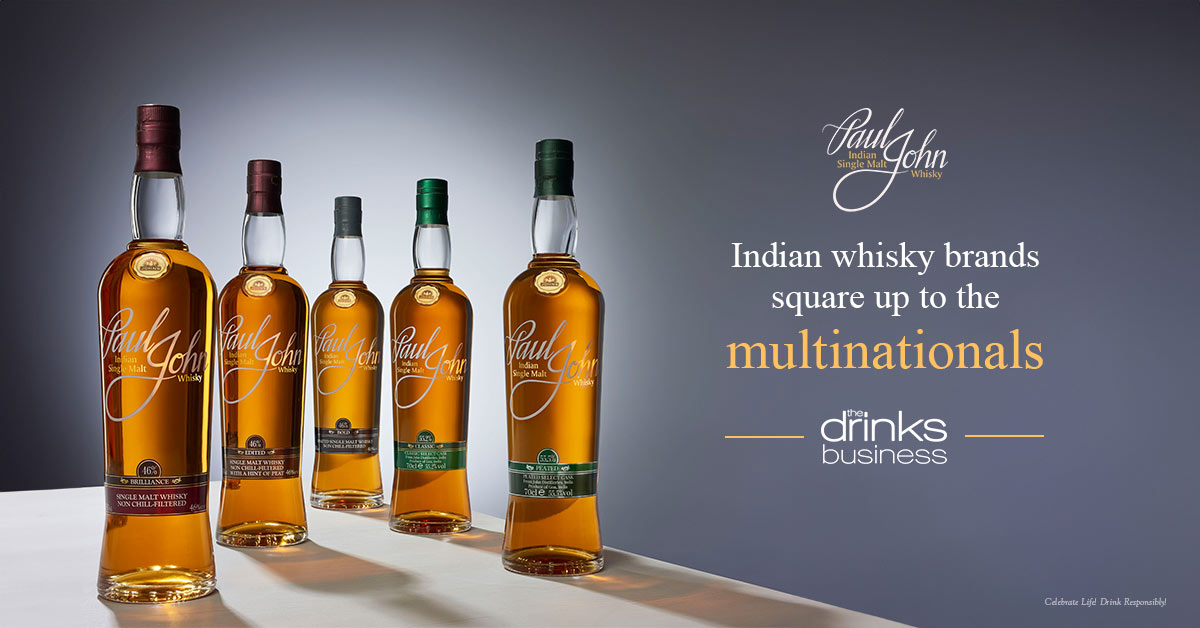
With a population of 1.4 billion, global whisky brands are tapping into India's rising buying power. But domestic producers are putting up a fair fight against the multinationals, and have cornered more than half of the Indian market for the first time. Eloise Feilden finds out more.
India is fast becoming a major producer of single malt whiskies, and brands are finding favour with domestic consumers.
Indian single malts have cornered a share of about 53% of domestic sales in 2023, early estimates prepared by industry body the Confederation of Indian Alcoholic Beverage Companies (CIABC) reveal.
Indian-origin single malt makers sold approximately 345,000 cases (nine litres each) in India in 2023, out of total sales of around 675,000 cases. Scotch and international producers were responsible for the remaining 330,000 cases sold.
Vinod Giri, director-general of CIABC, told the Times of India this was a “significant milestone” for domestic producers, who experienced growth of approximately 23% in 2023 compared with a “more conservative” 11% growth for imported brands.
So why is Indian-made whisky surging?
Heemanshu Ashar, global ambassador and new product developer at Indian single malt maker Paul John told the drinks business that the creation of “quality producers in Indian whiskies” focusing exclusively on the category of Indian single malts have spurred sales.
Growth also comes down to the growing economic freedoms of Indian consumers themselves. Francis Gabriel Godad, business development manager at GlobalData India, argues that there has been growing momentum for a “made in India” movement, coupled with “affluent Indians increasingly take pride in consuming domestic whiskies over those aged in Scotland”.
India remains a vital market for Scotch producers, even as domestic Indian whisky sales grow. In 2022, India replaced France as the largest Scotch whisky market by volume in the world, according to figures released by the Scotch Whisky Association (SWA). France has now taken back its top position, but in H1 2023, India remained a high-volume export market for Scottish-made whisky, with the equivalent of 72m bottles exported.
The rivalry between Indian-made single malts and Scotch comes down to production. Indian single malts are made as per SWA guidelines, as the country is yet to have its own regulations on whisky making. This doesn't mean, however, that the spirits are void of their own signature flavour.
“The flavour profiles contributed by Indian 6 Row Barley, domestic yeasts, tropical ageing etc. lend a unique flavour that now defines what is collectively called the Indian single malts,” says Ashar. “Further, the unique opportunity to experiment with distillation, casks for maturing and finishing offers newer opportunities for innovation leading to unique limited releases or limited editions.”
This unique quality is precisely the appeal of Indian whisky, both among domestic consumers and whisky lovers more broadly.
Ashar believes that “Indian whiskies have been gaining acceptance in core whisky markets because of their taste profiles that are unique from tropical ageing”.
Indian consumers, it seems, are also late to the game, Indian whisky's appeal on home turf has followed success abroad. Ashar explains: “Indian single malts grew internationally first and, stirred from their success overseas, the Indian consumer took notice of this category.”
Paul John first launched its single malts into the UK market in 2012, 18 months prior to launching domestically. The brand is now available in 45 countries, highlighting its global appeal. “The Indian Single Malts of the pioneering years were exporting first before offering it in India,” Ashar adds.
They say that imitation is the highest form of flattery. Global brands have begun producing single malts in India — a key indication of Indian whisky's success.
Just one week after Pernod Ricard launched its first China-made whisky, the company also released an Indian single malt in December last year. The company predicts a threefold jump in sales in India over the next decade as the country's economy expands and the growing middle class spends more of its disposable income on better quality, higher priced IMFL and imported brands.
GlobalData India's Godad says that international brands are looking to “ride the Indian single malt wave”. He name checks Pernod Ricard, whose Longitude 77 is set to expand globally, starting with Dubai.
Godad concludes: “Growing income levels, rising preference for whiskys that pair well with Indian cuisine and the shifting focus on consuming domestically made whisky will continue to push more global brands to embrace the “made-in-India” tag, as Indian palettes and spirit making comes of age.”
To read original news, Click Here.


